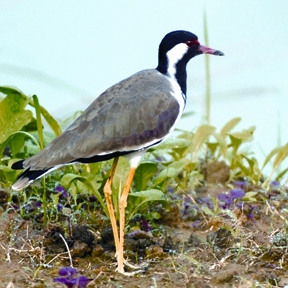Lapwing

Lapwing gregarious plovers of the order Perciformes having long legs, delicate bills, head crests, and unusually broad, rounded wings. These birds mostly occur in the Old World and South America.
The birds give a 'pee-wit' call and make its presence conspicuous, thus one of its vernacular names became Peewit. It frequents open country, fields and farmland; in winter, some are found in mud flats. They make hollow nest on the ground, usually with a lining of grass stems. Lapwing food consists mostly of insects, worms and other invertebrates, as well as some vegetable matter, such as seeds and algae, sometimes feeds on frogs and tadpoles.
There are 20 species of lapwings. Bangladesh has seven, of which three are resident, four are migratory. Among the resident lapwing, which are of the order Ciconiiformes (Charadriiformes), family Charadriidae, the River Lapwings (Spur-winged Lapwing) have their habitats mostly along the river Padma and in the coastal areas. Others in this group, seen in different areas of Bangladesh, are Red-wattled Lapwing (Vanellus indicus), locally called Lal-lotika Hot-ti-ti, and Yellow-wattled Lapwing (Vanellus malabaricus), locally called Hot-ti-ti. The migratory species of lapwings are of the family Glareolidae and their varieties are Grey-headed Lapwing (Vanellus cinereus, locally called Dhushor Ti-ti.), Sociable Lapwing (Vanellus gregarius, locally called Hot-ti-ti), White-tailed Lapwing (Vanellus leucurus, locally called Sadaleji Titriva), and Northern Lapwing (Vanellus vanellus). Of the resident lapwings, River Lapwing is endangered. [Md. Anwarul Islam]
